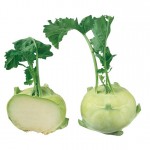Kohlrabi – Kyssäkaali (kaalirapi)
Brassica oleracea var. gongylodes L
Brassicaceae family
Soon after the young kohlrabi plant begins to grow, its stem begins to swell, finally forming an often slightly flattened spherical shape. From this lightly waxed green or lilac swollen stem the leaf stems grow as from a normal stem.
Kohlrabi is often ready to eat 50-60 days after planting, when stems are about 7-12cm in diameter. At harvesting the plants are pulled from the ground and the root removed by cutting at the point where it meets the stem. This requires a strong sharp knife or some old robust secateurs. The leaves which will not last long postharvest are best removed by careful trimming.
The most common quality problem is to allow the stem to become ´woody`, this happens more rapidly to some varieties than to others and makes the stem almost inedible. To avoid this, learn to grow the best varieties or harvest the older varieties in good time. Other quality problems are splitting, insect damage, and harvesting when they have become too big and poorly shaped.
A common mistake is to confuse a kohlrabi with a root crop such as turnip or swede, and presume it stores as well as these. Most kohlrabi varieties do not store well, and we have all seen the shriveled dry specimens for sale in the supermarkets. storage in the fridge for 1-2 weeks after harvest is probably still safe, but to enjoy kohlrabi at its best it should be eaten fresh.
Nutritionally kohlrabi is excellent and similar with other brassicas, containing a good selection of minerals and vitamins. Its crispiness and delicate flavour make it an easy vegetable to enjoy raw.
Growing kohlrabi is relatively easy so long as you protect it with fleece or insect net. When grown from a transplant, you must remember not to replant too deeply, avoiding that the lower part of the stem does not later contact the soil as it swells. This ensures a clean stem, with an even colour that is easy to harvest.
Remember also that this is a fast growing vegetable and can be planted as late as early July giving a fresh supply of Kohlrabi well into autumn. kohlrabi is available from mid-summer to early November if planted in stages from early May to mid-July.
Kohlrabi tartar
(side dish, 4 people)
- 1 kohlrabi
- 1 onion
- 2-3 green onion
- 200 g turkish yoghurt
- cornflowers for decoration (Centaurea cyanus)
- salt
Pickling marinade:
- 0,5 dl white wine vinegar
- 0,5 dl sugar
- 1 dl water
Instructions: Put a nonwoven cloth inside the strainer and pour the yogurt over the cloth and let it drain overnight to remove the excess liquid. Prepare the pickle broth by boiling the broth ingredients together in a pot. Chop the onion, pour the pickle broth over it and let it season overnight. Cut the kohlrabi into small cubes. Cut the chives into thin rings. Drain the onions from the pickle broth and mix with the drained yogurt and kohlrabi. Stir in half of the chives and leave the rest for decoration. Season with salt. Garnish with the remaining chives and cornflower (Centaurea cyanus) petals.


